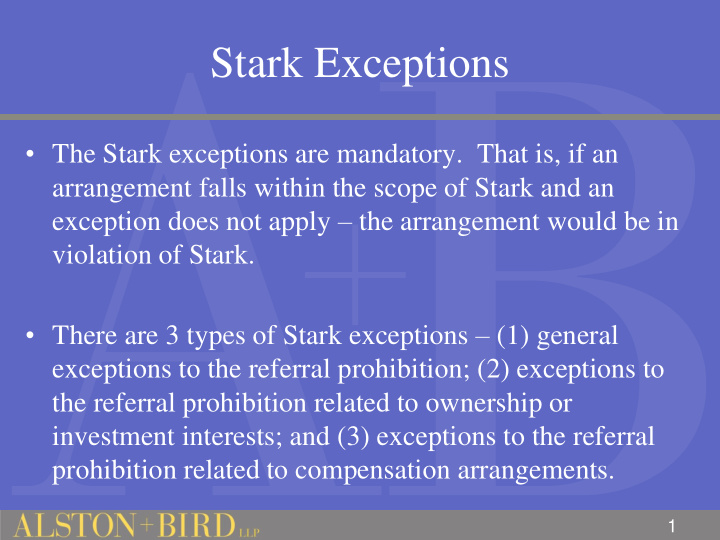



Stark Exceptions • The Stark exceptions are mandatory. That is, if an arrangement falls within the scope of Stark and an exception does not apply – the arrangement would be in violation of Stark. • There are 3 types of Stark exceptions – (1) general exceptions to the referral prohibition; (2) exceptions to the referral prohibition related to ownership or investment interests; and (3) exceptions to the referral prohibition related to compensation arrangements. 1
In-Office Ancillary Services Exception (IOAS) • The IOAS exception allows certain services (other than durable medical equipment and parenteral and enteral nutrients) to be provided ancillary to medical services provided by a physician or group practice so long as certain requirements are met. – Services are furnished by – (1) the referring physician, (2) a physician who is a member of the same group practice as the referring physician, or (3) an individual who is supervised by the referring physician or another physician in the group practice. – Services are furnished in – (1) the “same building,” (2) a “centralized building” that is used by the group practice for the provision of some or all of the group practice’s clinical laboratory services, or (3) a “centralized building” that is used by the group practice for the provision of some or all of the group practice’s DHS. – Services are billed by – (1) the physician performing or supervising the service, (2) the group practice of which the performing or supervising physician is a member under a billing number assigned to the group practice, (3) the group practice if the supervising physician is a physician in the group practice under a billing number assigned to the group practice, (4) an entity that is wholly owned by the performing or supervising physician or by that physician’s group practice under the entity’s own billing number or under a billing number assigned to the physician or group practice, or (5) an independent 3 rd party billing company acting as an agent of the physician, group practice, or entity described above. 2
In-Office Ancillary Services Exception • In Phase III, CMS expressed its concern with respect to the IOAS exception being used as a vehicle for physician self-referrals for services that are not closely connected to the physician practice. • As such, CMS has made a few clarifications with respect to the IOAS exception: – CMS reinforced its view that a physician or group practice may use this exception, but it is not available to hospitals for hospital inpatient or outpatient services rendered by physician employees. – CMS declined the opportunity to quantify the amount of services unrelated to DHS that must be provided to satisfy the “same building” requirement. However, CMS noted that that the evaluation would focus on the nature of the group’s overall practice and the referring physician’s full range of practice. 3
In-Office Ancillary Services Exception – CMS cautioned that shared facility arrangements must be carefully structured and operated to ensure that the facility and staffing be under the control of the physician at the time the DHS is furnished. Importantly, CMS indicated that it likely would require the lease arrangement for the space and equipment used to provide the DHS to be for specific blocks of time determined in advance (i.e., block lease arrangements). – CMS noted that it will again address concerns related to potentially abusive arrangements with respect to the “centralized building” requirement. 4
Recommend
More recommend